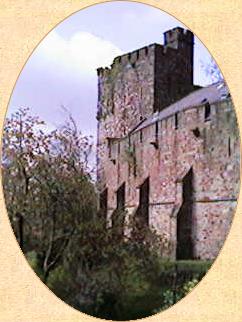
Gerald
of Wales
 Gerald,
archdeacon of Brecon, toured Wales in 1188 with the
archbishop of Canterbury gathering support for the crusades.
His written account of the journey is a valuable snapshot of
the times with some fascinating glimpses of the de Braoses.
Gerald,
archdeacon of Brecon, toured Wales in 1188 with the
archbishop of Canterbury gathering support for the crusades.
His written account of the journey is a valuable snapshot of
the times with some fascinating glimpses of the de Braoses.
Three surviving versions
of Gerald's travel diary each show a different treatment of William
de Braose. The first describes the barbaric murder of the Welsh
princes at Abergavenny, though Gerald leaves some doubt as to
the extent of William's guilt. By the time of the second version,
and the death of some key figures in the story, William had deeply
impressed Gerald as a friend and benefactor. Now we learn how
William was powerless to prevent a wicked plot inspired by Henry
II from taking place under his own roof.
Ranulf Poer, sheriff of
Hereford was at the feast. He was responsible for the killings
and had acted on the king's secret orders, including the removal
of William to ensure he could not restrain his men. This account
tells how William was tossed into the castle moat by the sheriff's
carefully placed impostors. After the massacre William was dragged
out of the water and set upon, but rescued without injury by
his own men. Seisyll's sons later murdered Ranulf in revenge.
(10.1)
William's worldly tales
of skirmishes with Welsh bowmen were eagerly repeated by Gerald.
(10.2) Equally, he was anxious to paint
William as a picture of piety. His scribes, we are told, had
tedious work adding extensive wishes for God's blessing at the
end of every letter. William gave them an extra gold piece each
year for their efforts. "By the grace of God" and "In
God's name" were favourite phrases of both William and his
wife. Her virtues were "rare among women". (10.3)
 Gerald's
fawning comments may have been influenced by his dangerous neighbour's
increasing power. By the time his career ambitions were past,
Gerald wrote more impartially that only God could judge the fate
of such men's souls. Nonetheless, William gave flattering endorsements
of Gerald's books and there seems to have been a real mutual
affection. In a letter to pope Innocent, Gerald could not resist
repeating a compliment on his good looks paid to him by Maud
de Saint Valery.
Gerald's
fawning comments may have been influenced by his dangerous neighbour's
increasing power. By the time his career ambitions were past,
Gerald wrote more impartially that only God could judge the fate
of such men's souls. Nonetheless, William gave flattering endorsements
of Gerald's books and there seems to have been a real mutual
affection. In a letter to pope Innocent, Gerald could not resist
repeating a compliment on his good looks paid to him by Maud
de Saint Valery.
An alternative portrait
of William is given in another of Gerald's stories. The priest
of the St Nicholas chapel in Brecon
castle had three
disturbing visions. Each time he saw a venerable old man who
warned that William de Braose had kept for his own use property
granted to the chapel for charitable purposes.
The priest went to Gerald,
who interpreted the vision. It was saint Augustine foretelling
the fall of William de Braose: "What is not surrendered
to Christ is removed by taxation and what you refuse to a priest
you will hand over to a godless soldier." The godless soldier
turned out to be king John. (10.4)

back to text

back to text
 Gerald of Wales |
||||
Three surviving versions of Gerald's travel diary each show a different treatment of William de Braose. The first describes the barbaric murder of the Welsh princes at Abergavenny, though Gerald leaves some doubt as to the extent of William's guilt. By the time of the second version, and the death of some key figures in the story, William had deeply impressed Gerald as a friend and benefactor. Now we learn how William was powerless to prevent a wicked plot inspired by Henry II from taking place under his own roof. Ranulf Poer, sheriff of Hereford was at the feast. He was responsible for the killings and had acted on the king's secret orders, including the removal of William to ensure he could not restrain his men. This account tells how William was tossed into the castle moat by the sheriff's carefully placed impostors. After the massacre William was dragged out of the water and set upon, but rescued without injury by his own men. Seisyll's sons later murdered Ranulf in revenge. (10.1) William's worldly tales of skirmishes with Welsh bowmen were eagerly repeated by Gerald. (10.2) Equally, he was anxious to paint William as a picture of piety. His scribes, we are told, had tedious work adding extensive wishes for God's blessing at the end of every letter. William gave them an extra gold piece each year for their efforts. "By the grace of God" and "In God's name" were favourite phrases of both William and his wife. Her virtues were "rare among women". (10.3)
An alternative portrait of William is given in another of Gerald's stories. The priest of the St Nicholas chapel in Brecon castle had three disturbing visions. Each time he saw a venerable old man who warned that William de Braose had kept for his own use property granted to the chapel for charitable purposes. The priest went to Gerald,
who interpreted the vision. It was saint Augustine foretelling
the fall of William de Braose: "What is not surrendered
to Christ is removed by taxation and what you refuse to a priest
you will hand over to a godless soldier." The godless soldier
turned out to be king John. (10.4)
|
||||